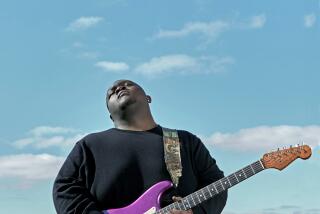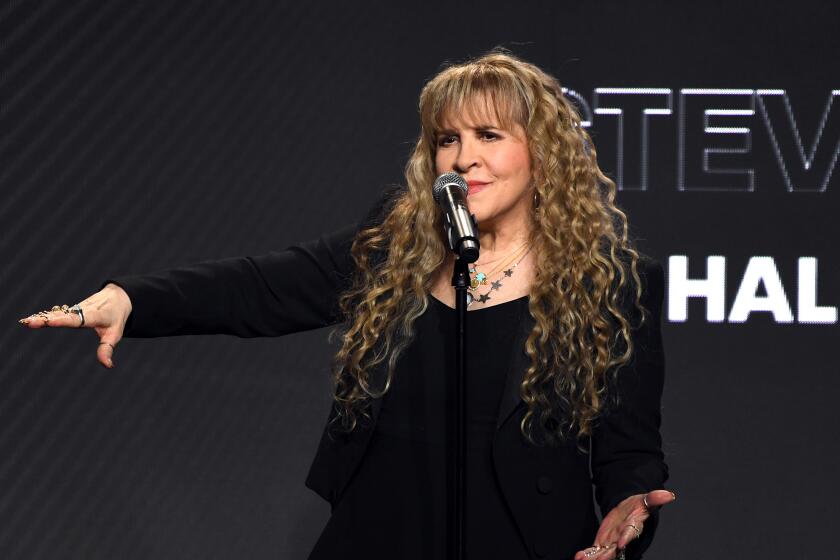The Art of Bait and Switch
- Share via
HOLLYWOOD — After nearly 20 years as a band, Fishbone has pretty much been there and done that on the grand tour of pop music’s stylistic possibilities.
Grounded in funk and soul, steeped in ska, dipped in punk, pop and heavy metal, with each style likely to surface in the course of a given show, or even a given song, the Los Angeles band, which plays the Galaxy in Santa Ana tonight, has made a point of finding links when the musical selling machinery typically insists on putting up fences to better corral a marketing demographic.
Last week, in their cramped, dark studio in a small building fronting a busy street, Fishbone’s five members took yet another stylistic leap, this time into the venerable art of playing for strippers.
*
Well, not exactly strippers. Shayla Laveaux, an actress and producer in the erotic-film trade, had approached Fishbone about supplying something more artistic than the usual tacky hack-work porno-flick backing music for two scenes from an upcoming feature called “Nina, Shayla and Kylie’s Barcelona Home Videos.”
“We’ve always acknowledged the sexual side of life, sometimes more than others,” reasoned Norwood Fisher, the band’s bassist. “I don’t think the porno industry is that taboo anymore. You’ve got Howard Stern doing stuff with porno stars all the time, and sex is the biggest-selling thing on the Internet.”
So there was Fishbone, behind a sliding glass door, drawing inspiration from a video monitor with a tape showing Laveaux and a female co-star taking the notion of “Dirty Dancing” to extremes.
Angelo Moore, Fishbone’s singer and sax player, stepped out of the sound booth to compliment Laveaux, who was sitting by the studio’s control board, watching the band improvise its contribution to her video.
“Some good moves there,” he said, then resumed playing in the time-honored, raunchy swing fashion of horn players backing strippers. But, this being Fishbone, something unorthodox was afoot: Spacey T, the band’s new guitar player, was chipping away with a scratchy ska rhythm.
Far from hopping a trend, the guitarist was underscoring Fishbone’s historical role as an early spark for the American “Third Wave” ska revival.
But if Fishbone was on the ground floor of the ska movement, it failed to catch a ride to the penthouse where No Doubt, the Mighty Mighty Bosstones and a handful of other hit bands now reside.
After solid, if not spectacular, sales in the ‘80s and early ‘90s, Fishbone’s SoundScan-monitored sales have dipped from nearly 200,000 for “The Reality of My Surroundings” in 1991 to 36,000 for its most recent release, “Chim Chim’s Badass Revenge.”
One reason the band was free to back Laveaux was that it has no record deal and, therefore, no corporate types to veto such a momentary digression.
The band’s main agenda nowadays was evident on a studio bulletin board in blue marker ink: a vertical column of 23 song titles, the new material Fishbone hopes will rekindle its prospects in the pop marketplace. At least five of those have heavy ska content, Moore noted.
Fisher said the band, while retaining its usual stylistic mix, is emphasizing ska these days: “We’ve always allowed some of the current things that are happening to influence us.”
Moore, Fisher, trumpet player Walter Kibby and Fisher’s younger brother, Phillip “Fish” Fisher, were teenagers jamming in Norwood Fisher’s bedroom in 1979 or 1980 when they discovered ska music by accident.
“We were playing some reggae to the best of our ability,” Norwood Fisher recalled. “We decided to try to speed it up to punk-rock speed. I personally thought we’d invented something new at that point: punk-rock reggae.”
Kibby, a few years older and better schooled in musical styles than his buddies, put the damper on that heady idea.
“Walt said, ‘You idiot, there’s a world of bands playing that.’ Walter brought his tapes to the next rehearsal to prove that we didn’t invent it.”
Starting with those tapes by the Specials and other English “2-Tone” ska-punk bands of the late ‘70s and early ‘80s, Fishbone’s members learned more about ska’s true invention by Jamaican musicians in the late ‘50s and early ‘60s. Only one other Southern California band, the more traditionalist Untouchables, was playing ska in 1983 when Fishbone debuted on the L.A. club scene.
“We did feel like we were a part of that [ska] scene, but we were working every scene in L.A.,” Fisher recalled. “Ska became a music we loved. We played a lot more of it than funk, [even though funk] was probably the major influence in our lives.”
*
Some of No Doubt’s first appearances in major clubs were opening slots on bills headlined by Fishbone. Moore recalls going to Anaheim to hang out with Eric Stefani, who started No Doubt with his sister, Gwen.
“All of this [ska success] was built off the things the Untouchables and Fishbone sweated over,” Fisher said. “Two black bands and neither one has a record deal now when ska is the biggest thing on the planet. Sometimes when it’s difficult for us to make our rents; it gets to be slightly frustrating knowing that what you do well can make you a lot of money, and you don’t have an outlet for it.”
“I think it’s a conspiracy,” Moore chimed in, laughing.
Fishbone hasn’t lacked visibility lately, despite slackening album sales. It was one of the headlining bands on the 1996 Warped Tour and recently was opening act on a tour by 311, one of several recent-vintage bands that have scored hits with a stylistic collage not unlike what Fishbone has championed.
Moore and Fisher take heart from the way 311, Primus and others can genre-hop and score hits.
“The audiences just want to rock to what’s good,” Fisher said. “I don’t think we have to learn to write real pop songs. Fishbone needs to be as Fishbone as we can.”
* Fishbone, Bonafide, Khroma and Fly play tonight at the Galaxy Concert Theatre, 3503 S. Harbor Blvd., Santa Ana. 8 p.m. $16.50-$18.50. (714) 957-0600.
More to Read
The biggest entertainment stories
Get our big stories about Hollywood, film, television, music, arts, culture and more right in your inbox as soon as they publish.
You may occasionally receive promotional content from the Los Angeles Times.











